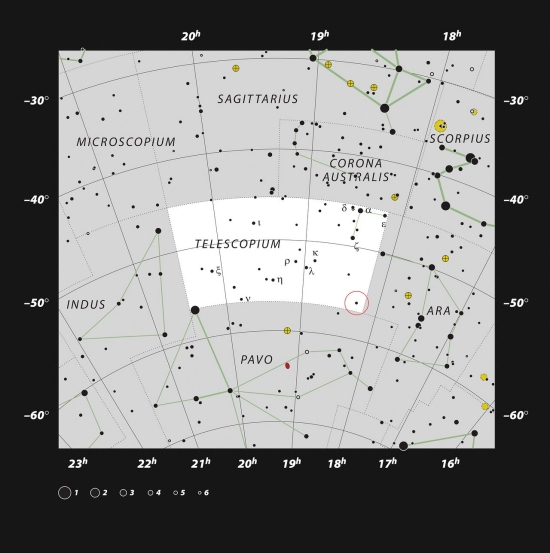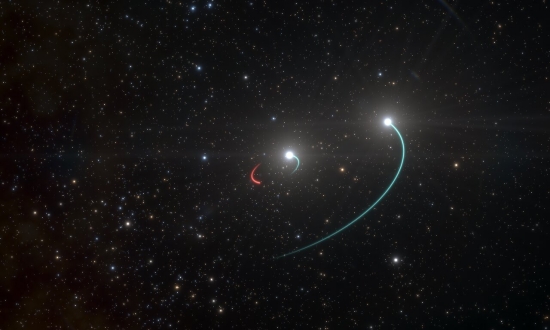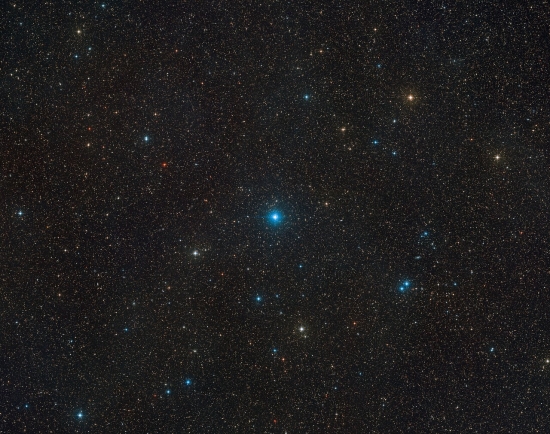Black holes are such exotic objects that they somehow suggest great distance. We’re learning about the black holes at the center of many galaxies even as we’re just beginning to catalog the location of smaller ones elsewhere. But we’re also learning through gravitational wave studies about their interactions and have begun to find black holes closer to home. Thus the just announced discovery of a black hole 1,000 light years from Earth. A long way, to be sure, but the closest ever found to our planet.
Evidence for the object comes from the MPG/ESO 2.2-metre telescope at ESO’s La Silla Observatory in Chile, deduced by a team of astronomers led by Thomas Rivinius from observations of two companion stars. This is, in other words, a triple system, and one that can be seen with the naked eye at that. The system is located in Telescopium, its stars viewable without binoculars or telescope on a clear southern hemisphere night. In fact, here’s where to look.

Image: This chart shows the location of the HR 6819 triple system, which includes the closest black hole to Earth, in the constellation of Telescopium. This map shows most of the stars visible to the unaided eye under good conditions and the system itself is marked with a red circle. While the black hole is invisible, the two stars in HR 6819 can be viewed from the southern hemisphere on a dark, clear night without binoculars or a telescope. Credit: ESO, IAU and Sky & Telescope.
The system is HR 6819, which was under study by the Rivinius team as part of an effort targeting double-star systems. It took the FEROS spectrograph on the La Silla instrument to show that one of the two visible stars orbits an unseen object every 40 days. The other star is at a large distance from the inner star/black hole pairing.

Image: This artist’s impression shows the orbits of the objects in the HR 6819 triple system. This system is made up of an inner binary with one star (orbit in blue) and a newly discovered black hole (orbit in red), as well as a third star in a wider orbit (also in blue). The team originally believed there were only two objects, the two stars, in the system. However, as they analysed their observations, they were stunned when they revealed a third, previously undiscovered body in HR 6819: a black hole, the closest ever found to Earth. The black hole is invisible, but it makes its presence known by its gravitational pull, which forces the luminous inner star into an orbit. The objects in this inner pair have roughly the same mass and circular orbits. The observations, with the FEROS spectrograph on the 2.2-metre telescope at ESO’s La Silla, showed that the inner visible star orbits the black hole every 40 days, while the second star is at a large distance from this inner pair. Credit: ESO/L. Calçada.
We are dealing with a stellar-mass black hole that shows no visible interactions with its environment, and thus had to be deduced from the orbit of the nearby star. As lead author Rivinius notes: “An invisible object with a mass at least 4 times that of the Sun can only be a black hole.” A reasonable conclusion, and a black hole that stands in contrast to the black holes previously discovered in the galaxy, nearly all of which are detectable through strong X-ray emissions as they affect nearby matter.
If we’ve found a black hole this comparatively close to the Solar System, what does this say about their numbers elsewhere? Rivinius speaks in terms of hundreds of millions of black holes, considering how many stars have ended their existence through gravitational collapse into such objects over the lifetime of the galaxy. Marianne Heida (ESO), a co-author of the paper, points to signs of another such system:
“We realised that another system, called LB-1, may also be such a triple, though we’d need more observations to say for sure. LB-1 is a bit further away from Earth but still pretty close in astronomical terms, so that means that probably many more of these systems exist. By finding and studying them we can learn a lot about the formation and evolution of those rare stars that begin their lives with more than about 8 times the mass of the Sun and end them in a supernova explosion that leaves behind a black hole.”

Image: This wide-field view shows the region of the sky, in the constellation of Telescopium, where HR 6819 can be found, a triple system consisting of two stars and the closest black hole to Earth ever found. This view was created from images forming part of the Digitized Sky Survey 2. Credit: ESO/Digitized Sky Survey 2. Acknowledgement: Davide De Martin.
We may also gain insights into the cosmic mergers that gravitational wave astronomy has shown us by studying systems like HR 6819. In such cases, we may be dealing with systems where the inner pairing is made up of two black holes, or a black hole and a neutron star. In that scenario, the outer star in the triple system could interact gravitationally so as to cause a merger that releases gravitational waves.

Before ending today’s article, I want to mention that the Rivinius paper is dedicated to the memory of the Czech astronomer Stanislav (Stan) Štefl, who died recently at age 58 in a car accident in Santiago, Chile. A tribute can be found here. Dr. Štefl worked at ESO Headquarters as a research associate and, from 2004 until 2012, was a Very Large Telescope Interferometer (VLTI) support astronomer at Paranal Observatory. For the past year and a half, he had been on assignment to the Atacama Large Millimeter/ submillimeter Array (ALMA), working in Santiago and at Chajnantor.
Although we discuss objects and distances at scales that defy the imagination, our community is a relatively small one. Such losses are wounds for us all.
The paper is Rivinius et al., “A naked-eye triple system with a non-accreting black hole in the inner binary,” Astronomy & Astrophysics Vol. 637, L3 (May, 2020). Abstract.



The latest on LB-1 is that the primary is a stripped helium star, while the companion appears to be a Be star (Shenar et al., arXiv 2020). Nevertheless the various rebuttals of the black hole hypothesis (including this one) have yet to be published in refereed journals, and there appears to have been some back-and-forth going on.
Could it be another high-mass low-luminosity object? A neutron star, a quark star, a strange star or something else? Or would we expect those to be visible?
If the mass estimate is correct it’s far too high for a neutron star. The others you list are very speculative at best. It’s a black hole or (per your second comment) some other type of low luminosity object.
Regarding your follow up: no, not really. Galactic mass is reasonably well characterized. The open questions are more to do with what comprises that mass. That there must be a large quantity of solar mass black holes is expected. However searches for a large enough quantity of compact massive objects (see MACHO) to significantly explain the large non-luminous galactic mass have been negative. Dark matter is still dark.
Re Ron’s comment, this from the paper, which corroborates the fact that the mass precludes a neutron star:
“HR 6819 is not positionally coincident with any known pulsar. The lower limit of 4.2 M? on the mass of the unseen object is substantially above the empirical mass limit of ?2.6 M? for NSs (Alsing et al. 2018), moreover, a companion mass close to that limit would imply an unbelievably low mass for the B star, and also falls into the possible gap between observed masses of NSs and BHs. Therefore, the unseen object must be a BH.”
Thank you both very much for your replies.
Yeah, the paper discusses an extant gap between numbers of observed black holes vs. Numbers predicted from stellar population models; so this discovery was waiting in the wings.
Oops. Forgot about the tiny mass range for exotic objects.
Follow-up comment: Does this discovery have any implications for galactic mass estimates and dark matter physics?
Thank you very much for your excellent website.
When reading about this my first impression was that it might be a Dyson Sphere. That would not make much sense, build something valuable that close to 2 supernovas in the not too distant future.
After giving it some thought, I remember mentioning before, where are all the black holes? Let me explain, B and O type stars form in the large blue galactic clouds that form after the arm of spiral galaxy moves thru a high-density area of gas and dust. This is one of the reason you see the large blue clouds in color images of spiral galaxies. They range from 2 to 3 solar mass in the B9 to O0 mass in excess of 150 solar mass and and make up about 1 out of every thousand stars. Looking at conservatively what generally should form black holes being B4 and above or =>10 solar mass and with a <32 million year lifetime.
This should give a number of black holes forming over the 13.5 lifetime of our spiral galaxy. My best guesstament is of over 400 black hole with in 1000 light years of our solar system. This means that a 3.2 solar mass or higher black hole should be in the 10 to 5o light years distance from us!
So where are they? These black holes are probably the most valuable real estate in the universe and have been developed by ETs in creating wormholes for interstellar travel and invisibility because of interstellar security. So how could we go about finding the most precious commodity in the universe? :-}
At least someone agrees with me!
How Close To Earth Is The Closest Black Hole?
We just found the first one within 1,000 light-years of us. But there’s probably one much, much closer.
https://medium.com/starts-with-a-bang/how-close-to-earth-is-the-closest-black-hole-4dfa4f4cdebf
I wonder what the HR 6819 system black hole looks like in the black body spectrum, infra red, x rays, etc. If it does not have much of an accretion disk, it might be only known indirectly by the stars in the visible light orbiting it. Maybe it will have a rare occultation.
Two ways at each end of the EM radiation might work. Gamma-rays burst or repeaters encountering the black hole would lose a virtual positron or electron to black hole leaving hawking radiation. This might be timed to Gamma burst here to get an exact distance to the BH. ELF to LF radio waves are larger then the black hole so should be some type of indicator in reflection or refraction of these long radio waves. This probable depends on the real size of the black hole and have not found a good write up on the size of 3.2 solar mass and up online.
Interesting point. The other two stars are resolvable from one another, so presumably the hole should be also … and I imagine it should provide a decent gravitational lens. I wonder if over the course of its orbit it is expected to transit anything interesting? I doubt that de Lacaille, placing a Telescopium in the sky, would have imagined it would actually be put to use!
What a beautiful gravilens this would make, an advanced spacefaring species would give an arm and a leg…or an antenna or two to be near one of these, but not to close though.
A phenomenal telescope AND sadly a weapon.
Yes, black holes may be the ultimate “mixed emotions” celestial objects. I don’t know how plausible the notion of a black hole transit network is (you and your starship must first survive the extreme tidal forces of the black holes at *both* ends of the “transit tube,” as well as the intense X-rays from the disc of debris ‘going down the drain,’ through each black hole’s event horizon). But a Freeman Dyson-type “gravity machine” composed of two black holes orbiting each other closely would make a terrific starprobe and starship launching system (and braking system, for arriving ones). Also:
Dangerous and/or particularly undesirable waste materials could also be disposed of by dumping them down a black hole. But one or more black holes that are close enough to be useful are also close enough to be dangerous; spacecraft that wandered too close would be torn apart by the powerful tidal force, even if they avoided being pulled down past the event horizon. And a black hole, set in slow translational motion by a sufficiently advanced hostile race (perhaps via asymmetrical compression of interstellar hydrogen), could destroy a solar system or force its planets into out-of-habitable-zone orbits, yet it would appear–to the victims–to be an unfortunate but wholly natural occurrence.
James, you had my curiosity but now you have my attention. A Freeman Dyson-type “gravity machine” composed of two black holes orbiting each other closely. If you could be so kind as to refer me to where details on this subject can be found I would greatly appreciate the reference. Thank you in advance.
Sending a black hole to derail a planet seems like the attack of a civilization, not so different from our own, where raw inefficiency has become the status symbol of the powerful. A more practical civilization might suppose that with all the comets in a cubic parsec, interstellar treaty enforcers must have omitted one from their database somewhere. Besides, who would believe that dinosaurs were capable of broadcasting prime numbers and hopeful messages of peace? :)
The tight focusing power could be used to converge high energy radiation and particle beams across the galaxy onto a civilisation system.
An interesting possibility and exactly what I was thinking! We have unusual phenomenon happening in our atmosphere every day that could be a focused local area event. This may be the way a alien civilization make contact with more primitive virgin cultures so as not to produce psychosis. A prime example of what would happen if direct contact with a large enough population could cause the type of psychosis that CORVID-19 is having on us now. I believe that small scale interactions with a culture would by default be the norm if all ETs are benevolent. What better way than to monitor the results of their work then a nearby mini to large star size black holes (inches to 10 miles in size). This would keep them almost completely anonymous from the population at large but still cause enough curiosity in the rest of the population to have development of ancient astronomical megaliths to giant telescopes.
A species that had a BH at their disposal would be formidable to any creatures in the galaxy. It also allows for very powerful telescope in which light can be bounced back and forth around the BH after been bent allowing for incredible imaging focusing.
Who controls one of these will be a very powerful and potentially dangerous species !
After LB-1, it’s now HR 6819’s turn for the stripped star hypothesis:
Bodensteiner et al. (2020) “Is HR 6819 a triple system containing a black hole? — An alternative explanation”
In this model, the system is binary rather than triple. The primary is suggested to be a low-mass stripped star rather than a normal B-type giant, and the Be star is the 40-day companion object instead of being an outer tertiary companion of a 40-day inner binary.
Another paper that comes to the same conclusion regarding the system:
El-Badry & Quataert (2020) “A stripped-companion origin for Be stars: clues from the putative black holes HR 6819 and LB-1”
Also the following paper, arguing that the originally-proposed triple system is a highly improbable configuration. (They don’t attempt to determine the reflex motion of the Be star, so they suggest an explanation where the Be star is a background object)
Safarzadeh et al. (2020) “The nearest discovered black hole is likely not in a triple configuration“
After 50 Years, Experiment Finally Shows Energy Could Be Extracted From a Black Hole
MICHELLE STARR
25 JUNE 2020
A 50-year-old theoretical process for extracting energy from a rotating black hole finally has experimental verification.
Using an analogue of the components required, physicists have shown that the Penrose process is indeed a plausible mechanism to slurp out some of that rotational energy – if we could ever develop the means.
https://www.sciencealert.com/an-experiment-has-just-demonstrated-how-energy-could-be-extracted-from-a-black-hole
There might be one even closer:
https://www.cfa.harvard.edu/news/2020-13
The Monster in the Middle of the Milky Way Is…Spinning Slowly?
Release No.: 2020-28
For Release: Tuesday, October 20, 2020 – 9:00 am
Cambridge, MA –
The monstrous black hole at the center of the Milky Way galaxy—now of Nobel Prize fame—is proving yet again to be stranger than fiction. New research from scientists at the Center for Astrophysics | Harvard & Smithsonian (CfA), and the Center for Interdisciplinary Exploration and Research in Astrophysics (CIERA) at Northwestern University has revealed that the supermassive black hole at the center of the Milky Way galaxy is not spinning much, providing more evidence that it is unlikely to have a jet. The paper is published in The Astrophysical Journal Letters.
Supermassive black holes like SgrA*—the monstrous black hole at the center of the Milky Way galaxy—are characterized by just two numbers: mass and spin, but have a critical influence on the formation and evolution of galaxies. According to Dr. Avi Loeb, Frank B. Baird Jr. Professor of Science at Harvard and CfA astronomer, and co-author on the research, “black holes release a huge amount of energy that removes gas from galaxies and therefore shapes their star formation history.”
While scientists know that the mass of central black holes has a critical influence on their host galaxy, measuring the impact of their spin isn’t easy. As Loeb puts it, “the effect of black hole spin on the orbits of nearby stars is subtle and difficult to measure directly.”
https://www.cfa.harvard.edu/news/2020-28
Casting Doubt on a Nearby Black Hole
By Susanna Kohler on 16 October 2020
A few months ago, scientists announced the indirect detection of the nearest black hole to Earth. But another team is now suggesting a different explanation for this stellar puzzle.
HR 6819: History of a Mystery
From the earliest spectra of HR 6819, scientists identified this source as a bright, early-type Be star — a hot star with emission lines, likely due to the accretion of a circumstellar disk of material. As our ability to resolve detail in stellar spectra has advanced, however, a more complicated picture has emerged.
Studies in the 1980s revealed unexpected narrow absorption lines in HR 6819’s spectra, and a 2003 study showed that these lines were moving over time. This indicated that, though we couldn’t optically resolve them, there were two components of HR 6819: a Be star exhibiting no obvious motion, and a B3 III star on a 40-day orbit.
But what was the B3 III star orbiting? In May 2020, scientists announced an answer to the puzzle: HR 6819 must actually be a triple system. The B3 III star, they argued, is orbiting a black hole (which is why we don’t see evidence of it in the spectra), and the Be star is a distant tertiary companion, orbiting too slowly to have detectable motion.
Based on the B3 III star’s orbit, the black hole would need to weigh more than 4 solar masses — and at just 1,120 light-years distance from Earth, this object would be the closest black hole known. But could there be another explanation for HR 6819’s spectra?
Full article here:
https://aasnova.org/2020/10/16/casting-doubt-on-a-nearby-black-hole/